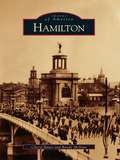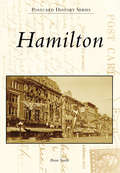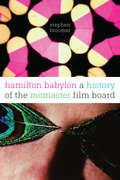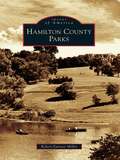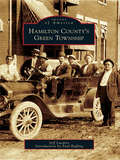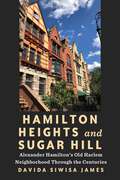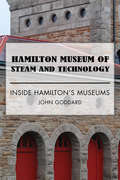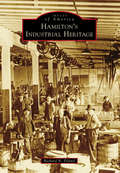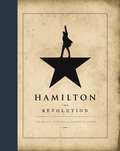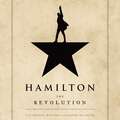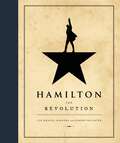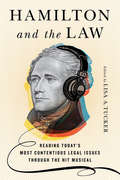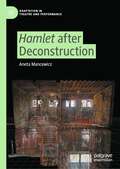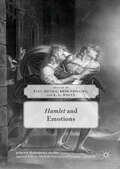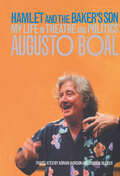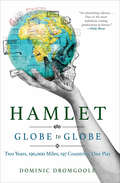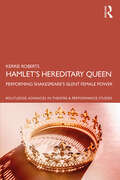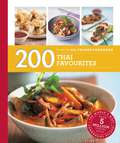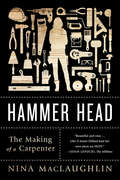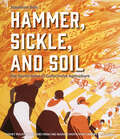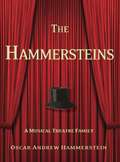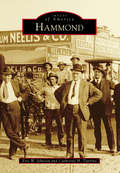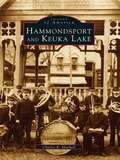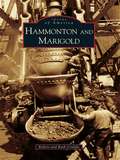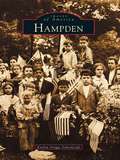- Table View
- List View
Hamilton
by Randy Mcnutt Cheryl BauerFounded as Fort Hamilton in 1791, the City of Hamilton was settled by pioneers and immigrants and was forged in steel by her talented workers and craftsmen. Factory owners became wealthy and built magnificent homes along Dayton Street. Hamilton prospered and became known as the "Greatest Little Industrial City of Its Kind in the World," home to Mosler Safe Co., Ford Motor Co., Beckett Papers, and many others. Following World War II, some factories closed their doors or moved away, but Hamilton persevered and became a city powered by small business and the arts. Through vintage images, this book showcases Hamilton's success, its survival of the Flood of 1913, its blue-collar job loss, and now, its rise as the "City of Sculpture," attracting sculptors from across the world.
Hamilton (Postcard History)
by Brian SmithThough not incorporated as a city until 1857, Hamilton can trace its roots back to the founding of Fort Hamilton by Gen. Arthur St. Clair in 1791.Throughout its history, Hamilton has been "The Greatest Little City of its Kind in the World," "The Postmark of Distinctive Trademarks," and "Known in the World's Markets." In the time between the close of the Civil War and the beginning of World War II, the city thrived. Led by steadfast pioneers and industrious immigrants, Hamilton developed into a community where anything seemed possible along the banks of the Great Miami River. The images herein detail Hamilton from 1900 to the 1950s. From a bustling county seat and the hub of Midwestern industry to leisurely endeavors, from distinctive neighborhoods to the people who lived in them, and from local education to individual worship, the life of the city is captured by over 200 postcards of the day, most from the author's private collection.
Hamilton Babylon
by Stephen BroomerFounded in 1966 at McMaster University by avant-garde filmmaker John Hofsess and future frat-comedy innovator Ivan Reitman, the McMaster Film Board was a milestone in the development of Canada's commercial and experimental film communities. McMaster's student film society quickly became the site of art filmmaking and an incubator for some of the country's most famous commercial talent - as the well as the birthplace of the first Canadian film to lead to obscenity charges, Hofsess's Columbus of Sex.In Hamilton Babylon, Stephen Broomer traces the history of the MFB from its birth as an organization for producing and exhibiting avant-garde films, through its transformation into a commercial-industrial enterprise, and into its final decline as a show business management style suppressed many of its voices. The first book to highlight the work of Hofsess, an innovative filmmaker whose critical role in the MFB has been almost entirely eclipsed by Reitman's legend, Hamilton Babylon is a fascinating study of the tension between art and business in the growth of the Canadian film industry.
Hamilton County Parks
by Robert Earnest MillerHamilton County parks have long been popular destinations for a variety of outdoor activities such as hiking, fishing, golf, and boating. At the same time, the parks have worked diligently to preserve wetlands, prairies, and other natural habitats. Hamilton County Parks explores a fascinating and little explored chapter of Hamilton County history. It spans more than 75 years of local history, tracing the development of the park system and the services it has provided its residents over the years. Join author Robert Earnest Miller as he tells the story of the Hamilton County parks through photographs and other visual materials from an extensive collection maintained by the staff of the Hamilton County Park District. The vast majority of these images have never been published or displayed for the public before.
Hamilton County's Green Township (Images of America)
by Paul Ruffing Jeff LuedersThe Green Township communities of Bridgetown, Covedale, Dent, Mack, Monfort Heights, and White Oak had their humble beginnings in 1809. By the early 1900s, Green Township was primarily a rural farming community. The advent of the streetcar, and eventually the automobile, made traveling much easier. New and improved roads and better cars in the 1930s and 1940s enabled workers to commute to Cincinnati or the industrial Millcreek Valley. With this growth, the west side expanded greatly with the building of new homes, schools, and churches. By 1940, there were 18,500 Green Township residents. By 1960, the number had grown to more than 37,300. The 2000 census listed 55,660 residents, making Green Township the second-largest township in Ohio.
Hamilton Heights and Sugar Hill: Alexander Hamilton’s Old Harlem Neighborhood Through the Centuries
by Davida Siwisa JamesExplores four centuries of colonization, land divisions, and urban development around this historic landmark neighborhood in West HarlemIt was the neighborhood where Alexander Hamilton built his country home, George Gershwin wrote his first hit, a young Norman Rockwell discovered he liked to draw, and Ralph Ellison wrote Invisible Man. Through words and pictures, Hamilton Heights and Sugar Hill traces the transition of this picturesque section of Harlem from lush farmland in the early 1600s to its modern-day growth as a unique Manhattan neighborhood highlighted by stunning architecture, Harlem Renaissance gatherings, and the famous residents who called it home. Stretching from approximately 135th Street and Edgecombe Avenue to around 165th, all the way to the Hudson River, this small section in the Heights of West Harlem is home to so many significant events, so many extraordinary people, and so much of New York’s most stunning architecture, it’s hard to believe one place could contain all that majesty. Author Davida Siwisa James brings to compelling literary life the unique residents and dwelling places of this Harlem neighborhood that stands at the heart of the country’s founding. Here she uncovers the long-lost history of the transitions to Hamilton Grange in the aftermath of Alexander Hamilton’s death and the building boom from about 1885 to 1930 that made it one of Manhattan’s most historic and architecturally desirable neighborhoods, now and a century ago. The book also shares the story of the LaGuardia High School of Music & Art, one of the fi rst in the nation to focus on arts and music. The author chronicles the history of the James A. Bailey House, as well as the Morris-Jumel Mansion, Manhattan’s oldest surviving residence and famously known as George Washington’s headquarters at the start of the American Revolution. By telling the history of its vibrant people and the beautiful architecture of this lovely, well-maintained historic landmark neighborhood, James also dispels the misconception that Harlem was primarily a ghetto wasteland. The book also touches upon the Great Migration of Blacks leaving the South who landed in Harlem, helping it become the mecca for African Americans, including such Harlem Renaissance artists and luminaries as Thurgood Marshall, Count Basie, Duke Ellington, Mary Lou Williams, Paul Robeson, Regina Anderson Andrews, and W. E. B. Du Bois.
Hamilton Museum of Steam and Technology: Inside Hamilton's Museums
by John GoddardInside Hamilton’s Museums helps to satisfy a growing curiosity about Canada’s steel capital as it evolves into a post-industrial city and cultural destination. In this special excerpt we visit Hamilton Museum of Steam and Technology, which displays the wondrous twin waterworks engines that supplied the City of Hamilton with fresh, safe drinking water. John Goddard takes us on a detailed tour of the dignified limestone building, providing fascinating historical background and insight into the waterworks.
Hamilton's Industrial Heritage
by Richard N. PilandHamilton has been an important activity center in Butler County since its founding in 1791, as its proximity to the Great Miami River made it an ideal county seat and agricultural hub. Beginning in 1845, the Hamilton Hydraulic Company diverted the river's flow through town and developed a system that supplied cheap waterpower to area mills. By 1900, Hamilton was "the greatest manufacturing city of its size in the world," and by the 1940s it was home to several of the world's largest industries. Champion Paper milled coated paper, Niles Tool Works manufactured machine tools, Hooven-Owens-Rentschler built Corliss engines, Estate Stove made stoves, and Mosler and Herring-Hall-Marvin Safe Companies earned Hamilton its reputation as the "Safe Capital of the World." More than 150 factories and shops developed diverse product lists in the early 1900s, but only three of these businesses still operate in Hamilton today.
Hamilton: The Revolution
by Lin-Manuel Miranda Jeremy McCarterWinner of the 2016 Pulitzer Prize for DramaNow a major motion picture, available on Disney Plus.Goodreads best non-fiction book of 2016From Tony Award-winning composer-lyricist-star Lin-Manuel Miranda comes a backstage pass to his groundbreaking, hit musical Hamilton.Lin-Manuel Miranda's groundbreaking musical Hamilton is as revolutionary as its subject, the poor kid from the Caribbean who fought the British, defended the Constitution, and helped to found the United States. Fusing hip-hop, pop, R&B, and the best traditions of theater, this once-in-a-generation show broadens the sound of Broadway, reveals the storytelling power of rap, and claims the origins of the United States for a diverse new generation.HAMILTON: THE REVOLUTION gives readers an unprecedented view of both revolutions, from the only two writers able to provide it. Miranda, along with Jeremy McCarter, a cultural critic and theater artist who was involved in the project from its earliest stages - "since before this was even a show," according to Miranda - traces its development from an improbable performance at the White House to its landmark opening night on Broadway six years later. In addition, Miranda has written more than 200 funny, revealing footnotes for his award-winning libretto, the full text of which is published here.Their account features photos by the renowned Frank Ockenfels and veteran Broadway photographer, Joan Marcus; exclusive looks at notebooks and emails; interviews with Questlove, Stephen Sondheim, leading political commentators, and more than 50 people involved with the production; and multiple appearances by President Obama himself. The book does more than tell the surprising story of how a Broadway musical became an international phenomenon: It demonstrates that America has always been renewed by the brash upstarts and brilliant outsiders, the men and women who don't throw away their shot.
Hamilton: The Revolution
by Lin-Manuel Miranda Jeremy McCarterWinner of the 2016 Pulitzer Prize for DramaNow a major motion picture, available on Disney Plus.Goodreads best non-fiction book of 2016From Tony Award-winning composer-lyricist-star Lin-Manuel Miranda comes a backstage pass to his groundbreaking, hit musical Hamilton.Lin-Manuel Miranda's groundbreaking musical Hamilton is as revolutionary as its subject, the poor kid from the Caribbean who fought the British, defended the Constitution, and helped to found the United States. Fusing hip-hop, pop, R&B, and the best traditions of theater, this once-in-a-generation show broadens the sound of Broadway, reveals the storytelling power of rap, and claims the origins of the United States for a diverse new generation.HAMILTON: THE REVOLUTION gives readers an unprecedented view of both revolutions, from the only two writers able to provide it. Miranda, along with Jeremy McCarter, a cultural critic and theater artist who was involved in the project from its earliest stages - "since before this was even a show," according to Miranda - traces its development from an improbable performance at the White House to its landmark opening night on Broadway six years later. In addition, Miranda has written more than 200 funny, revealing footnotes for his award-winning libretto, the full text of which is published here.Their account features photos by the renowned Frank Ockenfels and veteran Broadway photographer, Joan Marcus; exclusive looks at notebooks and emails; interviews with Questlove, Stephen Sondheim, leading political commentators, and more than 50 people involved with the production; and multiple appearances by President Obama himself. The book does more than tell the surprising story of how a Broadway musical became an international phenomenon: It demonstrates that America has always been renewed by the brash upstarts and brilliant outsiders, the men and women who don't throw away their shot.
Hamilton: The Revolution
by Lin-Manuel Miranda Jeremy MccarterWinner of the 2016 Pulitzer Prize for Drama<P><P>Lin-Manuel Miranda's groundbreaking musical Hamilton is as revolutionary as its subject, the poor kid from the Caribbean who fought the British, defended the Constitution, and helped to found the United States. Fusing hip-hop, pop, R&B, and the best traditions of theater, this once-in-a-generation show broadens the sound of Broadway, reveals the storytelling power of rap, and claims our country's origins for a diverse new generation. HAMILTON: THE REVOLUTION gives readers an unprecedented view of both revolutions, from the only two writers able to provide it. Miranda, along with Jeremy McCarter, a cultural critic and theater artist who was involved in the project from its earliest stages--"since before this was even a show," according to Miranda--traces its development from an improbable performance at the White House to its landmark opening night on Broadway six years later. In addition, Miranda has written more than 200 funny, revealing footnotes for his award-winning libretto, the full text of which is published here. Their account features photos by the renowned Frank Ockenfels and veteran Broadway photographer, Joan Marcus; exclusive looks at notebooks and emails; interviews with Questlove, Stephen Sondheim, leading political commentators, and more than 50 people involved with the production; and multiple appearances by President Obama himself. The book does more than tell the surprising story of how a Broadway musical became a national phenomenon: It demonstrates that America has always been renewed by the brash upstarts and brilliant outsiders, the men and women who don't throw away their shot.<P> Advisory: Bookshare has learned that this book offers only partial accessibility. We have kept it in the collection because it is useful for some of our members. To explore further access options with us, please contact us through the Book Quality link on the right sidebar. Benetech is actively working on projects to improve accessibility issues such as these. <P><b>A New York Times Bestseller</b>
Hamilton and the Law: Reading Today's Most Contentious Legal Issues through the Hit Musical
Since its Broadway debut, Hamilton: An American Musical has infused itself into the American experience: who shapes it, who owns it, who can rap it best. Lawyers and legal scholars, recognizing the way the musical speaks to some of our most complicated constitutional issues, have embraced Alexander Hamilton as the trendiest historical face in American civics. Hamilton and the Law offers a revealing look into the legal community's response to the musical, which continues to resonate in a country still deeply divided about the reach of the law. A star-powered cast of legal minds—from two former U.S. solicitors general to leading commentators on culture and society—contribute brief and engaging magazine-style articles to this lively book. Intellectual property scholars share their thoughts on Hamilton's inventive use of other sources, while family law scholars explore domestic violence. Critical race experts consider how Hamilton furthers our understanding of law and race, while authorities on the Second Amendment discuss the language of the Constitution's most contested passage. Legal scholars moonlighting as musicians discuss how the musical lifts history and law out of dusty archives and onto the public stage. This collection of minds, inspired by the phenomenon of the musical and the Constitutional Convention of 1787, urges us to heed Lin-Manuel Miranda and the Founding Fathers and to create something new, daring, and different.
Hamlet after Deconstruction (Adaptation in Theatre and Performance)
by Aneta MancewiczPost-war European adaptations of Hamlet are defined by ambiguities and inconsistencies. Such features are at odds with the traditional model of adaptation, which focuses on expanding and explaining the source. Inspired by Derrida’s deconstruction, this book introduces a new interpretative paradigm. Central to this paradigm is the idea that an act of adaptation consists in foregrounding gaps and incoherencies in the source; it is about questioning rather than clarifying. The book explores this paradigm through seven representative European adaptations of Hamlet produced between the 1960s and the 2010s: dramatic texts, live theatre productions, and a mixed reality performance. They systematically challenge the post-Romantic idea of Hamlet as a tragedy of great passions and heroic deeds. What does this say about Hamlet’s impact on post-war theatre and culture? The deconstructive analyses offered in this book show how adaptations of Hamlet capture crucial anxieties and concerns of post-war Europe, such as political disillusionment, postmodern scepticism, and feminist resistance, revealing exciting connections between European traditions.
Hamlet and Emotions (Palgrave Shakespeare Studies)
by R. S. White Paul Megna Bríd PhillipsThis volume bears potent testimony, not only to the dense complexity of Hamlet’s emotional dynamics, but also to the enduring fascination that audiences, adaptors, and academics have with what may well be Shakespeare’s moodiest play. Its chapters explore emotion in Hamlet, as well as the myriad emotions surrounding Hamlet’s debts to the medieval past, its relationship to the cultural milieu in which it was produced, its celebrated performance history, and its profound impact beyond the early modern era. Its component chapters are not unified by a single methodological approach. Some deal with a single emotion in Hamlet, while others analyse the emotional trajectory of a single character, and still others focus on a given emotional expression (e.g., sighing or crying). Some bring modern methodologies for studying emotion to bear on Hamlet, others explore how Hamlet anticipates modern discourses on emotion, and still others ask how Hamlet itself can complicate and contribute to our current understanding of emotion.
Hamlet and the Baker's Son: My Life in Theatre and Politics (Augusto Boal)
by Augusto BoalHamlet and the Baker's Son is the autobiography of Augusto Boal, inventor of the internationally renowned Forum Theatre system, and 'Theatre of the Oppressed' and author of Games for Actors and Non-Actors and Legislative Theatre. Continuing to travel the world giving workshops and inspiration to teachers, prisoners, actors and care-workers, Augusto Boal is a visionary as well as a product of his times - the Brazil of military dictatorship and artistic and social repression and was once imprisoned for his subversive activities. From his early days in Brazil's political theatre movement to his recent experiments with theatre as a democratic political process, Boal's story is a moving and memorable one. He has devised a unique way of using the stage to empower the disempowered, and taken his methods everywhere from the favelas of Rio to the rehearsal studios of the Royal Shakespeare Company.
Hamlet: Globe to Globe: Two Years, 190,000 Miles, 197 Countries, One Play
by Michael Gallagher Dominic DromgooleFrom the artistic director of Shakespeare’s Globe Theatre in London, an account of the theater’s extraordinary two-year tour bringing Hamlet to every country on earth
Hamlet’s Hereditary Queen: Performing Shakespeare's Silent Female Power (Routledge Advances in Theatre & Performance Studies)
by Kerrie RobertsThis book explores a fresh and insightful interpretation of Hamlet’s Gertrude as a prominent and powerful figure in the play. It shows how traditional readings of this character, both performance-based and scholarly, have been guided and constrained by misogynistic perspectives on female power. Bringing together the author’s wealth of insight from a theatre practitioner’s perspective and combining it with a scholarly perspective, the book argues that Gertrude need not be limited to sex and motherhood. She could instead be played as Denmark’s blood royal Queen, her role in the play then being about female political power. Gertrude’s royal status could play out on stage through a variety of possible performance choices for stage design, stage business, acting processes, and the actor’s presence – both speaking and silent. Hamlet's Hereditary Queen takes into consideration Shakespeare’s source myths, historical studies of the position of queens and the issues concerning them in early modern England, Hamlet’s performance history, and the text itself. It questions traditional readings of Hamlet, and offers detailed analyses of relevant scenes to demonstrate how Gertrude’s Hamlet might play out on stage in the twenty-first century. This is an engaging and insightful interpretation for students and scholars of theatre and performance studies and Shakespeare studies, as well as theatre practitioners.
Hamlyn All Colour Cookery: Hamlyn All Colour Cookbook (Hamlyn All Colour Cookery)
by Oi CheepchaiissaraThai food is globally renowned for its distinctive flavours and delicious mix of spicy and sour tastes. No matter what your level of ability, experiencing this wonderful cuisine need not be limited to restaurant visits - Hamlyn All Colour Cookbook: 200 Thai Favourites will allow you to re-create that authentic Thai flavour in your own home. From firm favourites such as red curry with roasted duck to the more exotic such as red snapper with three-flavour sauce, this book has a dish to suit everybody. Each recipe is accompanied by easy-to-follow instructions and a full page colour photograph to ensure perfect results.
Hammer Head: The Making of a Carpenter
by Nina MaclaughlinA warm and inspiring book for anyone who has ever dreamed of changing tracks: the story of a young woman who quit her desk job to become a carpenter. Nina MacLaughlin spent her twenties working at a Boston newspaper, sitting behind a desk and staring at a screen. Yearning for more tangible work, she applied for a job she saw on Craigslist--Carpenter's Assistant: Women strongly encouraged to apply--despite being a Classics major who couldn't tell a Phillips from a flathead screwdriver. She got the job, and in Hammer Head she tells the rich and entertaining story of becoming a carpenter. Writing with infectious curiosity, MacLaughlin describes the joys and frustrations of making things by hand, reveals the challenges of working as a woman in an occupation that is 99 percent male, and explains how manual labor changed the way she sees the world. We meet her unflappable mentor, Mary, a petite but tough carpenter-sage ("Be smarter than the tools!"), as well as wild demo dudes, foul-mouthed plumbers, grizzled hardware store clerks, and the colorful clients whose homes she and Mary work in. Whisking her readers from job to job--building a wall, remodeling a kitchen, gut-renovating a house--MacLaughlin examines the history of the tools she uses and the virtues and varieties of wood. Throughout, she draws on the wisdom of Ovid, Annie Dillard, Studs Terkel, and Mary Oliver to illuminate her experience of work. And, in a deeply moving climax, MacLaughlin strikes out on her own for the first time to build bookshelves for her own father. Hammer Head is a passionate book full of sweat, swearing, bashed thumbs, and a deep sense of finding real meaning in work and life.
Hammer, Sickle, and Soil: The Soviet Drive to Collectivize Agriculture
by Jonathan DalyIn Hammer, Sickle, and Soil, Jonathan Daly tells the harrowing story of Stalin's transformation of millions of family farms throughout the USSR into 250,000 collective farms during the period from 1929 to 1933. History's biggest experiment in social engineering at the time and the first example of the complete conquest of the bulk of a population by its rulers, the policy was above all intended to bring to Russia Marx's promised bright future of socialism. In the process, however, it caused widespread peasant unrest, massive relocations, and ultimately led to millions dying in the famine of 1932–33. Drawing on scholarly studies and primary-source collections published since the opening of the Soviet archives three decades ago, now, for the first time, this volume offers an accessible and accurate narrative for the general reader. The book is illustrated with propaganda posters from the period that graphically portray the drama and trauma of the revolution in Soviet agriculture under Stalin. In chilling detail the author describes how the havoc and destruction wrought in the countryside sowed the seeds of destruction of the entire Soviet experiment.
Hammersteins: A Musical Theatre Family
by Oscar Andrew HammersteinThe remarkable, unprecedented biography of the Hammersteins, Broadway's greatest and most influential family, as told by Oscar Andrew Hammerstein The Hammersteins is the story of one of Broadway's most creative and productive families. It is a story that begins in 1864 when Oscar Hammerstein I emigrates to America, establishes himself as a successful cigar merchant and turns his attention to the business of music and theaters. He builds many theaters including New York's most majestic opera house. He turns Times Square (then Longacre Square) into the theater capital of the world. His sons, Willie and Arthur carry on the tradition and nurture such talents as Will Rogers, W.C. Fields, Al Jolson, Houdini, and Charlie Chaplin. Willie's son Oscar II becomes the most successful lyricist of all time, writing the story and words to the Broadway shows Showboat, Oklahoma, South Pacific, Carousel, The King and I, and The Sound of Music. The accomplishments of this family are monumental. Their tale is enchanting. Written by Oscar "Andy" Hammerstein (Oscar II's grandson), TheHammersteins presents a multi-layered portrait of the Hammerstein legacy, complete with personal and professional highlights, as well as the scandals and tragedies. The book also draws heavily upon the family archives, presenting a rich collection of photographs, theatre blueprints, letters, programs, patents, and more, much of which has never been seen before. The Hammersteins is at once a deeply personal story of an American family living the American dream and a celebration of musical theater in this country.
Hammond (Images of America)
by Catherine H. Tijerino Eric W. JohnsonIdeally situated about an hour from New Orleans at the conjunction of two major interstates, the city of Hammond grew from a stop on the Illinois Central Railroad to a thriving business and cultural center northwest of Lake Pontchartrain. The area known for its cypress swamps and lush pine forests was first settled around 1818 by Swedish sailor Peter Hammond. The land was purchased for industrial pursuits, primarily for growing timber to make sail masts, other nautical goods, and charcoal. After entrepreneur Charles E. Cate and the railroad arrived, a flourishing timber industry and its fame as the "Strawberry Capital of the World" spurred Hammond's economic growth and influence in Tangipahoa Parish. Now home to Southeastern Louisiana University and an expanding health-care industry, Hammond's many historic homes and buildings remain as a testament to its importance in the history of the state.
Hammondsport and Keuka Lake: Penn Yan, Hammondsport And The Heart Of The Finger Lakes (Images of America)
by Charles R. MitchellLocated in the Finger Lakes of New York, Keuka Lakehas an intriguing history spattered with wineries,aerodynamics, and legendary people like Glenn Curtiss. Hammondsport and Keuka Lake continues geographically where Penn Yan and Keuka Lake left off. This historical work covers the periods from the 1850s to the 1960s, the period of black-and-white photography in this area. At one time Keuka Lake was host to a number of wineries lining the lake's shores. Several no longer exist, but throughthe pages of this book, one may look back and share in the magnificence of these businesses' hey days. A chapter is devoted to Glenn Curtiss, an innovative man who was building and testing airplanes at the same time the Wright brothers were working in aerodynamics. Hammondsport has definitely had a number of interesting characters and momentous occasions.
Hammonton and Marigold (Images of America)
by Robert Criddle Ruth CriddleThis is the story of one community and two towns: Hammonton and Marigold, companyowned dredger towns located 10 miles east of Marysville, California. Their founding was a direct result of the gold rush of 1849 and the subsequent hydraulic mining that followed. The towns' history was wrought by the families who inhabited them and the many men and women who would build their community together through the years. In Hammonton and Marigold, there was no upper or lower class; the people were all working for dredging companies and considered equals. Although the company towns were shut down and the families all displaced, in 1957, the community itself carried on to the present day, holding annual reunions and even publishing a quarterly newsletter.
Hampden
by Schoolcraft, Evelyn GriggsOriginally part of Springfield's outward commons, Hampden was called Wilbraham and then South Wilbraham until it was incorporated as Hampden in 1878. Its main street parallels the peaceful Scantic River, surrounded by mountains that lend a sense of mystery to this lovely New England village. By harnessing the Scantic's energy, this farming community became a booming mill town in the 1800s. When plans to build a railroad for transporting products from mills and quarries failed, industry collapsed. The town reverted back to farming and later became a bedroom community.Hampden brings readers back to the days when world-renowned Thornton W. Burgess wrote his Peter Rabbit books beside Laughing Brook and when Maude Tait, pioneer aviatrix whose speed record beat Amelia Earhart's, taught school in Hampden. The book tells the exciting stories of the people and places that formed the town, such as the early workers, businessmen, preachers, and teachers. Included in Hampden are early photographs of parades and plays, picnics and personalities, and the way of life before the advent of modern transportation, communication, and manner of business.
